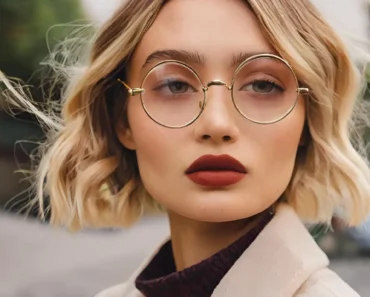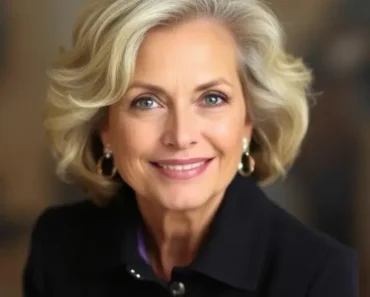Compression socks for women have evolved from medical necessity to everyday wellness essential, combining therapeutic benefits with fashionable designs that fit seamlessly into modern lifestyles. These specialized socks apply graduated pressure to improve circulation, reduce swelling, and provide comfort for women who spend long hours on their feet or face circulation challenges.The growing popularity of compression socks for women reflects increased awareness of preventive healthcare and the importance of supporting leg health before problems develop. From healthcare professionals to frequent travelers, active athletes to office workers, women across all professions are discovering the transformative benefits these socks can provide.
This comprehensive guide explores everything you need to know about compression socks for women – from understanding how they work to selecting the right compression level, style, and fit for your specific needs. We’ll help you navigate the options so you can make informed decisions that support your health, comfort, and personal style preferences.
Understanding How Compression Socks Work
Compression socks for women work by applying graduated pressure that is strongest around the ankle and gradually decreases as it moves up the leg. This pressure gradient helps push blood back toward the heart, counteracting the effects of gravity that can cause blood to pool in the lower legs and feet.
The science behind compression therapy lies in supporting the body’s circulatory system, particularly the venous return process. When blood struggles to flow efficiently back to the heart, it can lead to swelling, fatigue, and discomfort in the legs and feet. Compression socks provide external support that helps maintain proper blood flow and reduces the workload on your circulatory system.
Different compression levels provide varying degrees of support, measured in millimeters of mercury (mmHg). Understanding these levels helps you select compression socks for women that provide appropriate therapeutic benefits without being uncomfortable or restrictive for daily wear.
The graduated compression design ensures that pressure is distributed optimally throughout the sock, with the highest compression at the ankle where blood flow faces the greatest challenge against gravity. This scientific approach to pressure distribution makes compression socks effective tools for both treatment and prevention of circulation-related issues.
Health Benefits of Compression Socks for Women
Improved Circulation and Blood Flow
The primary benefit of compression socks for women is enhanced circulation throughout the lower extremities. By providing external pressure that supports venous return, these socks help prevent blood from pooling in the legs and feet, reducing the risk of circulation-related complications.
Improved blood flow delivers more oxygen and nutrients to leg muscles while helping remove metabolic waste products more efficiently. This enhanced circulation can reduce muscle fatigue, decrease recovery time after exercise, and provide overall comfort for women who experience leg heaviness or discomfort.
Reduction of Swelling and Edema
Compression socks effectively reduce swelling in the legs, ankles, and feet by preventing fluid accumulation in tissues. This benefit is particularly valuable for women who experience swelling due to pregnancy, prolonged standing, or medical conditions that affect fluid retention.
The graduated pressure helps move excess fluid back into the circulatory system, where it can be processed and eliminated by the body’s natural mechanisms. Regular use of compression socks can significantly reduce end-of-day swelling and the discomfort associated with fluid retention.
Prevention of Varicose Veins
Regular wear of compression socks for women can help prevent the development of varicose veins by supporting proper blood flow and reducing pressure on vein walls. While genetics play a significant role in varicose vein development, compression therapy provides valuable preventive support.
For women with family histories of varicose veins or risk factors such as pregnancy, prolonged standing, or obesity, compression socks offer proactive protection that may delay or prevent the onset of visible vein problems. Early intervention with compression therapy often proves more effective than treatment after problems develop.
Enhanced Athletic Performance and Recovery
Athletic compression socks provide performance benefits by improving oxygen delivery to muscles during exercise and reducing muscle vibration that can contribute to fatigue and soreness. Many female athletes report improved endurance and reduced post-workout muscle soreness when wearing compression socks.
The enhanced circulation also accelerates recovery by helping remove metabolic waste products like lactic acid more efficiently. This faster recovery process allows for more consistent training and better overall athletic performance over time.
Types and Compression Levels Explained
Understanding different compression levels helps you select compression socks for women that provide appropriate therapeutic benefits for your specific needs. Compression is measured in millimeters of mercury (mmHg), with higher numbers indicating stronger compression.
Mild Compression (8-15 mmHg)
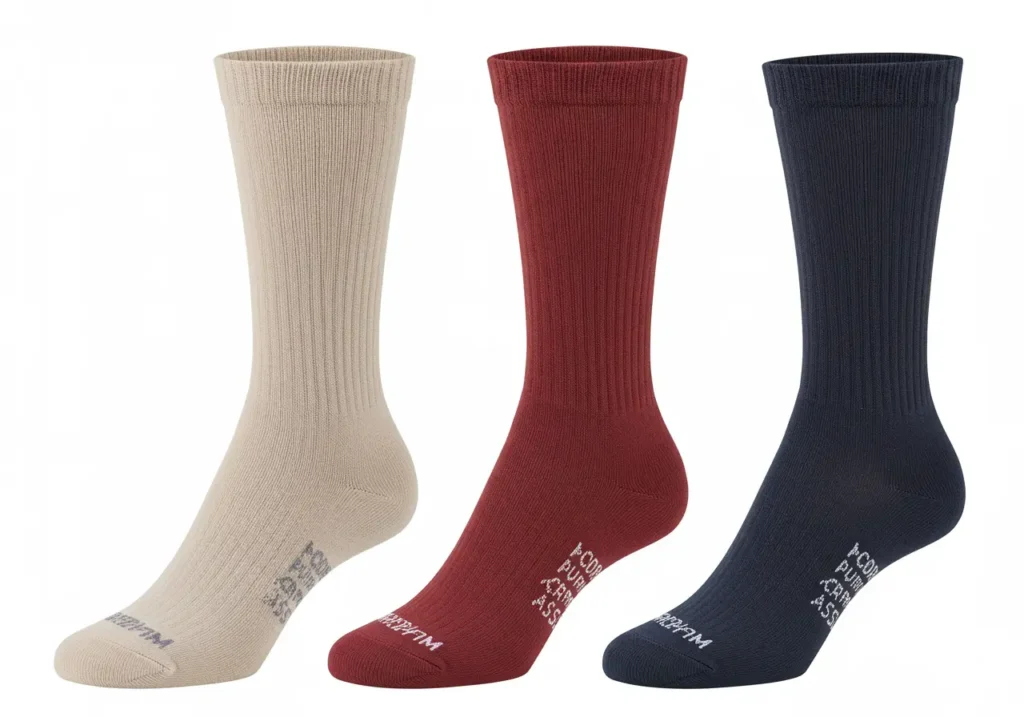
Mild compression socks provide gentle support suitable for everyday wear and prevention of minor leg fatigue. These compression socks for women work well for individuals who stand or sit for extended periods but don’t experience significant circulation issues.
This compression level offers comfort benefits without feeling restrictive, making it ideal for women new to compression therapy or those seeking preventive support. Mild compression socks can be worn daily without medical supervision and integrate easily into regular wardrobes.
Moderate Compression (15-20 mmHg)
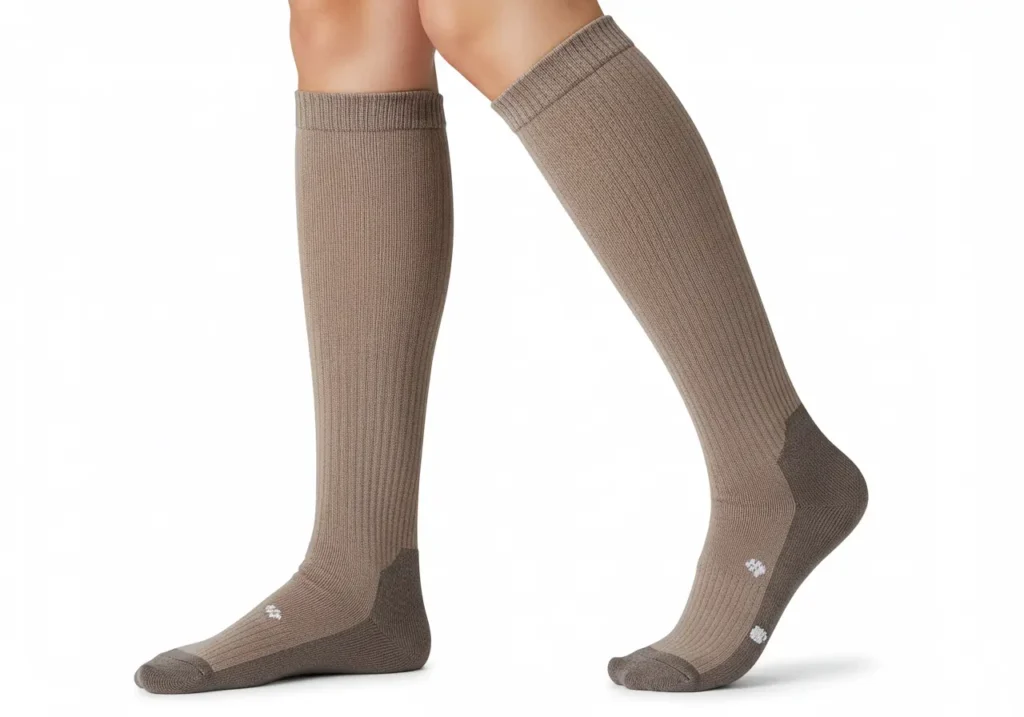
Moderate compression represents the most popular level for general wellness and minor circulation support. These compression socks for women provide noticeable benefits for reducing leg fatigue, minor swelling, and travel-related circulation issues.
This compression level works well for pregnant women, frequent travelers, healthcare workers, and anyone who experiences moderate leg discomfort or swelling. Moderate compression socks offer significant therapeutic benefits while remaining comfortable for all-day wear.
Firm Compression (20-30 mmHg)

Firm compression socks provide substantial therapeutic support for more significant circulation issues, moderate varicose veins, and post-surgical recovery. This level typically requires professional fitting and may need medical consultation before use.
These compression socks for women offer strong support for individuals with diagnosed circulation problems or those recovering from vein procedures. The increased pressure provides significant therapeutic benefits but may require an adjustment period for comfortable wear.
Extra Firm Compression (30-40 mmHg and higher)
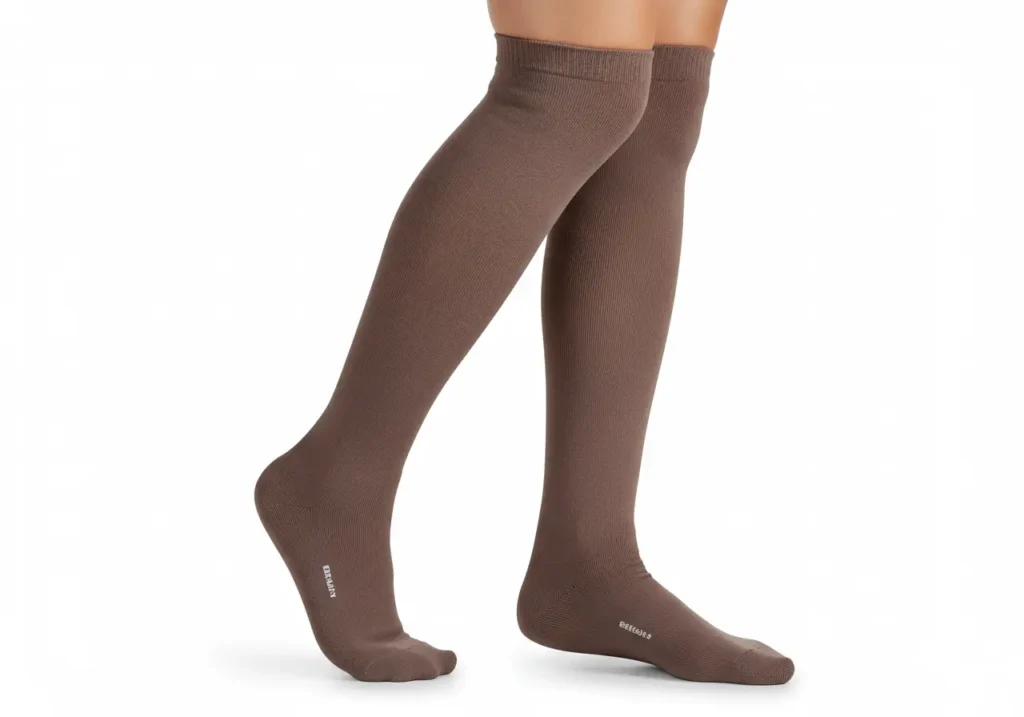
Extra firm compression is typically prescribed for severe circulation problems, significant varicose veins, or post-thrombotic syndrome. These compression socks for women require medical supervision and professional fitting to ensure safety and effectiveness.
This compression level provides maximum therapeutic support but should only be used under medical guidance. Proper fitting and regular monitoring ensure that the benefits outweigh any potential risks associated with high-compression therapy.
Choosing the Right Compression Socks for Your Needs
Selecting appropriate compression socks for women requires considering your specific health needs, lifestyle factors, and comfort preferences. Different activities and conditions benefit from particular compression levels and sock styles.
For Daily Comfort and Prevention
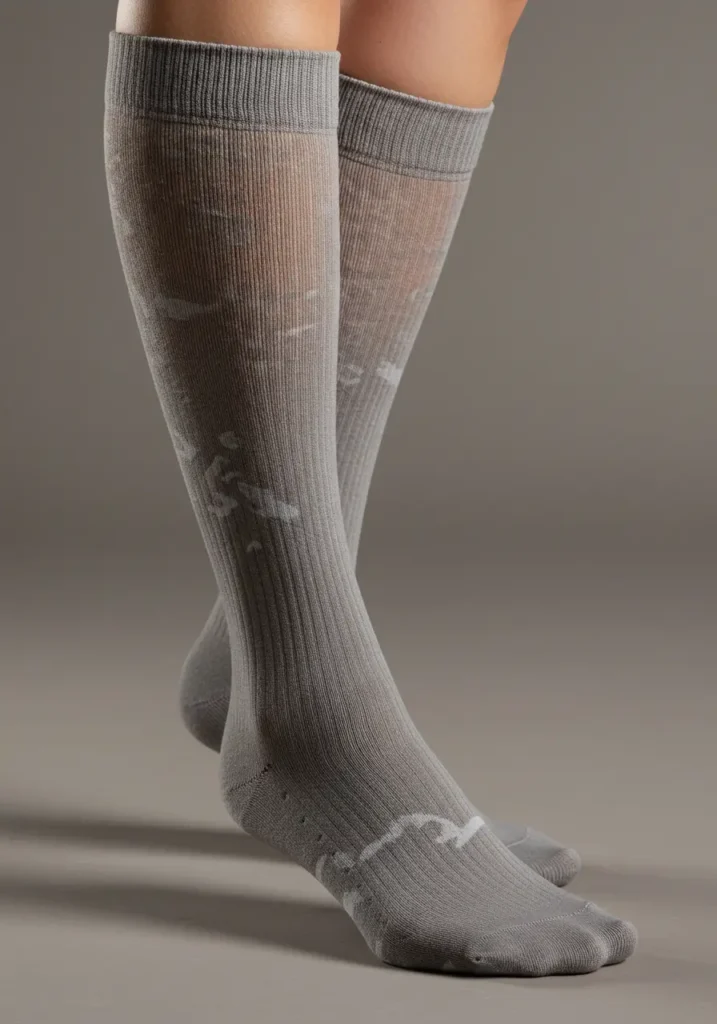
Women seeking general comfort and circulation support should consider mild to moderate compression (8-20 mmHg) in knee-high or crew styles. These compression socks for women provide daily benefits without medical complexity while fitting comfortably under most footwear.
Look for breathable materials, cushioned soles, and moisture-wicking properties that enhance comfort during extended wear. Seamless toe construction and flat seams prevent irritation during long days on your feet.
For Athletic Performance
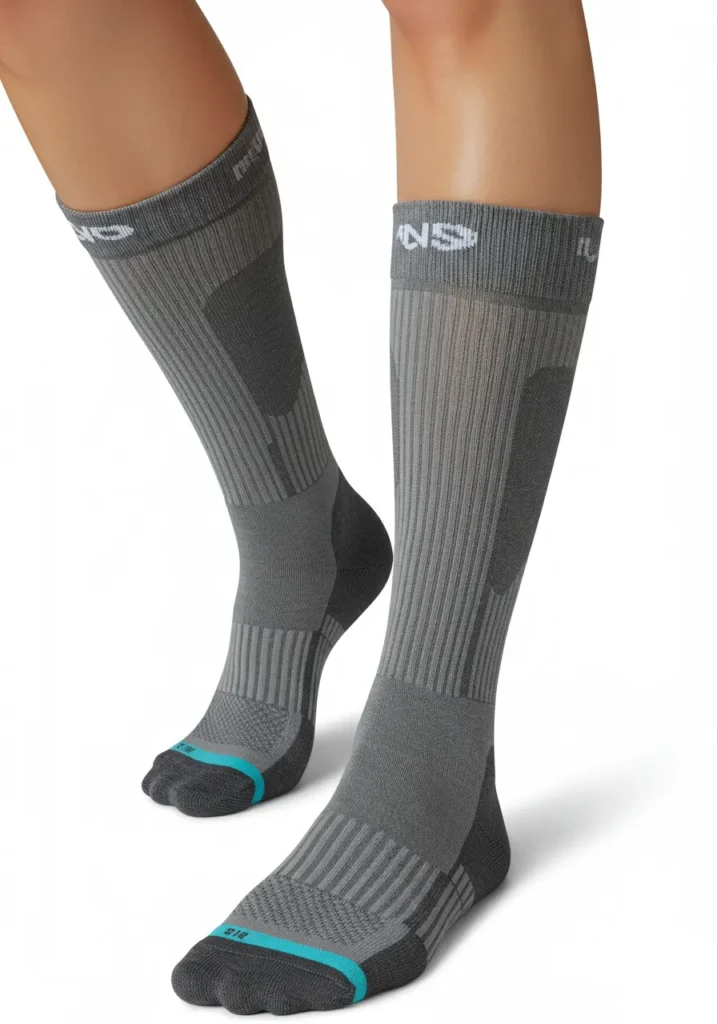
Athletic compression socks for women typically feature moderate compression (15-20 mmHg) combined with performance materials that wick moisture and provide targeted cushioning. Look for socks with arch support, heel and toe reinforcement, and seamless construction.
Consider calf-length or knee-high styles that provide compression to the major muscle groups involved in running, cycling, or other activities. Many athletic compression socks feature specialized zones that provide extra support where athletes need it most.
For Travel Comfort

Travel compression socks help prevent deep vein thrombosis and reduce leg swelling during long flights or car trips. Moderate compression (15-20 mmHg) in knee-high styles provides optimal benefits for travel situations where movement is restricted for extended periods.
Choose compression socks for women with breathable materials and comfortable fit that won’t create pressure points during prolonged sitting. Some travel-specific designs feature extra cushioning in areas that contact airplane or car seats.
For Medical Conditions
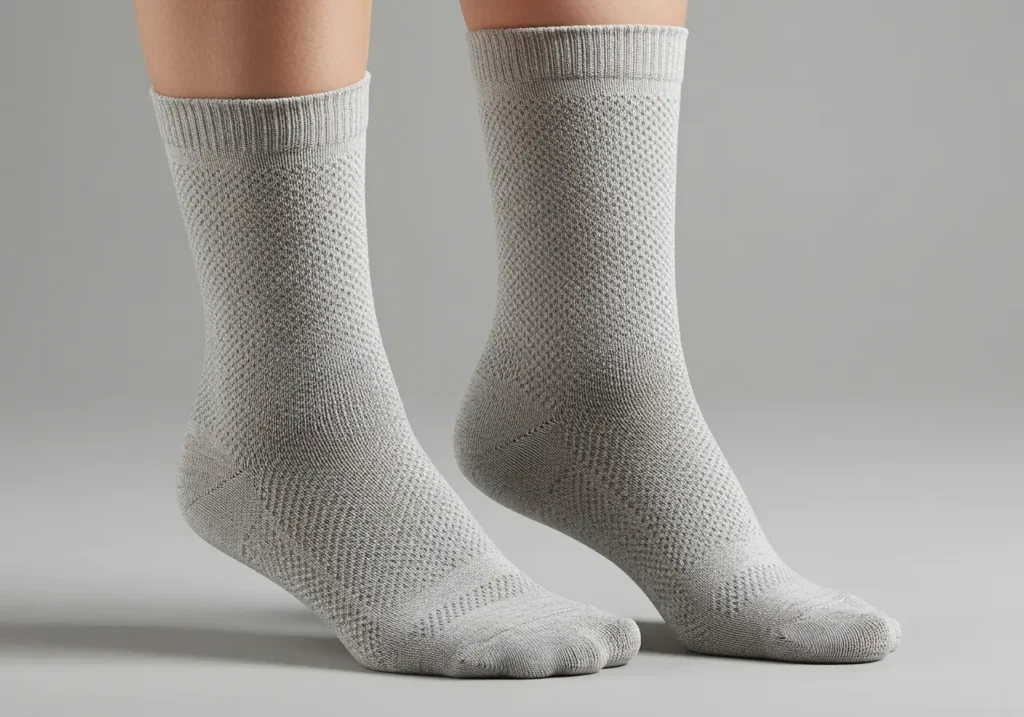
Women with diagnosed circulation problems, varicose veins, or post-surgical needs should consult healthcare providers before selecting compression socks. Medical-grade options typically require professional fitting and may involve firm to extra-firm compression levels.
Medical compression socks for women often feature specific design elements like extra-wide openings for swollen legs, antimicrobial treatments, or specialized materials that accommodate sensitive skin conditions.
Style and Fashion Options
Modern compression socks for women combine therapeutic benefits with fashionable designs that complement various outfits and occasions. The evolution from purely medical devices to stylish accessories has expanded options significantly.
Professional and Business Styles
Professional compression socks for women feature subtle designs, neutral colors, and refined appearances that work well with business attire. These socks provide health benefits while maintaining appropriate workplace aesthetics.
Look for compression socks in black, navy, beige, or gray that coordinate with professional wardrobes. Trouser-length styles work well with pants, while knee-high options can be worn with skirts or dresses when appropriate for workplace dress codes.
Casual and Everyday Options
Casual compression socks for women offer more variety in colors, patterns, and designs while maintaining therapeutic benefits. These options allow for personal expression while supporting leg health during daily activities.
Popular casual styles include fun patterns, bright colors, and seasonal designs that make wearing compression socks enjoyable rather than merely functional. Many brands now offer compression socks that look and feel like regular fashion socks.
Athletic and Performance Designs
Athletic compression socks feature technical designs optimized for various sports and activities. These compression socks for women often incorporate moisture-wicking materials, targeted cushioning, and performance-enhancing features.
Different sports benefit from specific design elements – running socks might feature extra toe protection, while cycling socks could have thinner profiles for better shoe fit. Many athletic compression socks use bold colors and dynamic designs that reflect active lifestyles.
Proper Fitting and Sizing Guide
Proper fit is crucial for compression socks for women to provide therapeutic benefits safely and comfortably. Incorrect sizing can reduce effectiveness or create pressure points that cause discomfort or complications.
Taking Accurate Measurements
Measure your legs first thing in the morning when swelling is minimal for the most accurate sizing. You’ll need measurements of ankle circumference, calf circumference, and leg length depending on the sock style you’re selecting.
Use a flexible measuring tape and measure snugly but don’t compress the tissue. Record measurements carefully, as even small differences can affect compression sock fit and effectiveness. Some brands provide detailed measuring guides specific to their sizing systems.
Understanding Size Charts
Different manufacturers use varying sizing systems for compression socks for women, so always consult brand-specific size charts rather than assuming standard sock sizes apply. Some brands size by measurements only, while others combine measurements with shoe sizes.
Pay particular attention to sizing ranges and overlap areas where you might fit multiple sizes. When measurements fall between sizes, consider your comfort preferences, the intended use, and any swelling patterns that might affect fit throughout the day.
Professional Fitting Services
For medical-grade compression socks or if you have specific health conditions, consider professional fitting services available at medical supply stores, specialty retailers, or healthcare facilities. Professional fitters can ensure optimal compression distribution and comfort.
Professional fitting becomes particularly important for firm compression levels (20-30 mmHg and higher) where improper fit can create health risks. Many fitters also provide education on proper application and care techniques.
Also Read: Black Boots for Women: The Ultimate Style Guide to Finding Your Perfect Pair
How to Wear and Care for Compression Socks
Proper application and care extend the lifespan of compression socks for women while ensuring they continue providing therapeutic benefits. Learning correct techniques maximizes your investment and maintains sock effectiveness.
Putting On Compression Socks
Apply compression socks first thing in the morning when legs are least swollen. Turn the sock inside out to the heel, place your foot in the foot portion, then gradually roll the sock up your leg, smoothing out wrinkles as you go.
Avoid bunching or folding the sock, which can create pressure points or reduce circulation. Some women find rubber gloves helpful for gripping and applying compression socks, especially higher compression levels that require more effort to put on.
Daily Wear Guidelines
Most compression socks for women can be worn all day and removed before bed, unless specifically directed otherwise by healthcare providers. New users should start with shorter wear periods and gradually increase as legs adjust to the compression.
Monitor your legs for any signs of discomfort, skin irritation, or circulation problems. Remove compression socks immediately if you experience numbness, tingling, or pain, and consult healthcare providers if problems persist.
Washing and Maintenance
Wash compression socks for women in cool water with mild detergent to preserve elastic fibers and therapeutic properties. Avoid fabric softeners, bleach, or harsh chemicals that can break down compression materials.
Air dry compression socks away from direct heat sources that can damage elastic fibers. Replace socks every 3-6 months with regular wear, as compression gradually decreases over time. Having multiple pairs allows for rotation while some are being washed.
Top Brands and Product Recommendations
The compression sock market offers numerous options for women, ranging from budget-friendly basic models to premium medical-grade products. Understanding brand strengths helps you select compression socks that meet your specific needs and budget.
Medical-Grade Brands
Jobst, Sigvaris, and Medi represent leading medical compression brands that offer compression socks for women with clinical-grade quality and therapeutic effectiveness. These brands typically require professional fitting and carry higher price points but provide superior durability and therapeutic benefits.
Medical-grade compression socks feature precise compression gradients, high-quality materials, and construction standards that ensure consistent therapeutic benefits. Many come with warranties and are eligible for insurance coverage when prescribed by healthcare providers.
Athletic Performance Brands
CEP, Compression, and Zensah specialize in athletic compression socks for women that combine therapeutic benefits with performance-enhancing features. These brands focus on materials and designs optimized for various sports and activities.
Athletic brands often incorporate moisture-wicking technologies, targeted cushioning, and seamless construction that enhances comfort during intense physical activity. Many offer sport-specific designs tailored to running, cycling, or other activities.
Fashion and Lifestyle Brands
Brands like Bombas, Comrad, and VIM & VIGR offer stylish compression socks for women that prioritize fashion alongside function. These options work well for daily wear and provide moderate compression benefits with appealing designs.
Fashion-focused brands typically offer broader color and pattern selections, making it easier to coordinate compression socks with various outfits. They often target the lifestyle market rather than medical users, focusing on comfort and style.
Special Considerations for Different Life Stages
Women’s needs for compression socks change throughout different life stages, with pregnancy, aging, and career demands creating specific requirements that influence sock selection and usage patterns.
Pregnancy and Maternity
Pregnant women often benefit from compression socks for women as hormonal changes and increased blood volume can affect circulation and cause leg swelling. Maternity compression socks feature designs that accommodate changing body shapes and provide gentle support.
Look for maternity-specific compression socks with extra stretch in the calf area and comfortable tops that don’t create pressure points on sensitive skin. Moderate compression (15-20 mmHg) typically provides appropriate support during pregnancy without medical supervision.
Active Professional Women
Healthcare workers, teachers, retail employees, and other professionals who spend long hours on their feet benefit significantly from compression socks for women. These occupational demands create circulation challenges that compression therapy can address effectively.
Professional-grade compression socks should prioritize comfort, durability, and appropriate compression levels that provide all-day support without fatigue. Many professionals prefer knee-high styles that provide comprehensive leg support during extended standing or walking.
Aging and Senior Health
Older women may experience age-related circulation changes that make compression socks increasingly beneficial for maintaining leg health and comfort. Senior-focused compression socks often feature easier application methods and skin-friendly materials.
Consider compression socks for women with wider openings, easier grip tabs, or other features that accommodate arthritis or limited mobility. Consulting healthcare providers helps ensure appropriate compression levels for age-related health conditions.
Common Myths and Misconceptions
Several misconceptions about compression socks for women can prevent individuals from experiencing their benefits or lead to inappropriate usage. Understanding facts versus myths helps you make informed decisions about compression therapy.
Myth: Compression Socks Are Only for Medical Problems
Many healthy women benefit from compression socks for prevention, comfort, and performance enhancement. You don’t need diagnosed circulation problems to experience benefits from mild to moderate compression during daily activities, travel, or exercise.
Preventive use of compression socks can help maintain leg health and comfort, particularly for women with risk factors like family history of vein problems, occupations requiring prolonged standing, or lifestyle factors that affect circulation.
Myth: Tighter Is Always Better
Appropriate compression levels depend on individual needs and conditions. Excessive compression can restrict circulation, cause discomfort, or create health risks. Always select compression socks for women based on intended use and professional recommendations when appropriate.
Higher compression levels require medical supervision and proper fitting to ensure safety and effectiveness. Starting with appropriate compression levels and adjusting based on response provides better outcomes than immediately choosing maximum compression.
Myth: Compression Socks Are Uncomfortable and Unattractive
Modern compression socks for women feature comfortable materials, attractive designs, and construction techniques that prioritize wearability alongside therapeutic benefits. Many users report that quality compression socks feel better than regular socks once they adjust to the compression.
Fashion options now include numerous colors, patterns, and styles that coordinate with various outfits and occasions. The evolution from purely medical devices to lifestyle accessories has dramatically improved both comfort and appearance.
Stepping Forward with Compression Sock Benefits
Compression socks for women represent a simple yet effective way to support leg health, enhance comfort, and prevent circulation-related problems before they develop. Whether you’re seeking relief from existing discomfort, preventive support for risk factors, or performance enhancement for athletic activities, compression socks offer valuable benefits that improve daily life quality.
The key to success with compression socks lies in selecting appropriate compression levels, ensuring proper fit, and choosing styles that align with your lifestyle needs and preferences. Taking time to understand your options and consulting healthcare providers when appropriate ensures you receive maximum benefits from compression therapy.
As awareness of preventive healthcare continues to grow, compression socks for women will likely become increasingly common tools for maintaining leg health and comfort throughout various life stages and activities. The combination of therapeutic benefits, improved comfort, and fashionable designs makes compression socks practical investments in long-term wellness.
Remember that compression socks work best as part of comprehensive approaches to leg health that include regular exercise, proper hydration, and attention to circulation-supporting habits. When integrated thoughtfully into your daily routine, compression socks can provide lasting benefits that support active, comfortable living for years to come.
Frequently Asked Questions
What compression level should I choose as a beginner?
Beginners should start with mild to moderate compression (8-20 mmHg) for general comfort and circulation support. This range provides noticeable benefits without feeling restrictive or requiring medical supervision. You can always increase compression levels later if needed, but starting conservatively helps ensure comfortable adjustment to compression therapy.
How long should I wear compression socks each day?
Most compression socks for women can be worn all day and removed before bed, unless directed otherwise by healthcare providers. New users should start with shorter periods (2-4 hours) and gradually increase wear time as legs adjust to the compression. Remove socks immediately if you experience discomfort, numbness, or circulation problems.
Can I sleep in compression socks?
Generally, compression socks should be removed before sleeping unless specifically prescribed by a healthcare provider for nighttime wear. Your legs naturally elevate during sleep, reducing the need for compression assistance with circulation. Wearing compression socks to bed may also cause discomfort or interfere with sleep quality for most people.
How do I know if my compression socks fit properly?
Properly fitting compression socks feel snug but not painful, with even pressure distribution and no bunching or wrinkles. You should be able to move normally without restriction, and the socks shouldn’t leave deep indentations in your skin. If you experience numbness, tingling, or pain, the socks may be too tight or improperly sized.
How often should I replace my compression socks?
Replace compression socks every 3-6 months with regular wear, as the elastic fibers gradually lose their compression effectiveness over time. Signs it’s time for replacement include visible stretching, reduced compression feeling, holes or thinning areas, and decreased comfort or therapeutic benefits. Having multiple pairs allows for rotation and extends overall lifespan.
This Post Contains Affiliate Links









